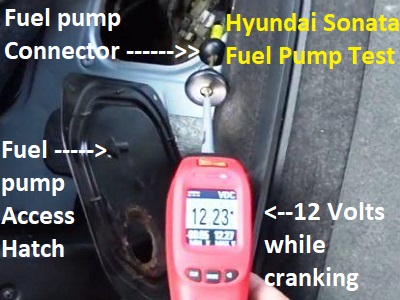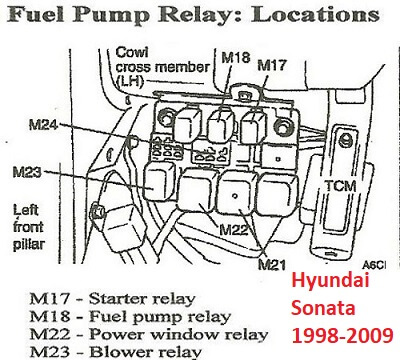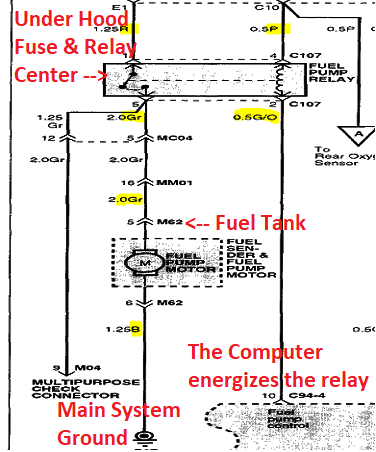Hyundai Sonata Fuel Pump
We write about the Hyundai Sonata fuel pump problem today, because we just solved an ongoing intermittent issue on a friends 2004 Sonata. Let me share with you what we found.
I'll break from my tradition of first explaining the operation of the fuel system electrical circuit and how the component works. Yes, I will just tell you what fixed this car. Then I'll add the juicy diagnostic and repair details later.
This almost 20 year old, single owner Hyundai Sonata has 225,000 miles on it. The original factory installed fuel pump went all of this distance. Pretty impressive for any car.
Quick Link: New
Hyundai Sonata electric fuel pump
with sending unit. Fits Hyundai model years 2001 - 2019
It helped that she never ran the tank dry. When this happens you can suck up tiny particles that damage the pump internally. After the car quit running on the highway the driver towed it to a local shop.
After some testing they replaced the fuel pump. Ever since then the automobile has become unreliable with an intermittent no start and no fuel pressure issues.
Let me be upfront with you and say that I stumbled onto the problem by pure accident. On the Hyundai vehicles, we have the luxury of gaining access to the top of the fuel tank through an inspection hatch.
 Hyundai Fuel Pump Testing
Hyundai Fuel Pump TestingAlthough I'm not a fan of these cars, this easy access is off the hook. I would've begged the engineers for an access panel when I replaced the fuel pump on a Chevy Cavalier.
My intention was to pull the pump module out of the Sonata and look for recent repair issues. I thought maybe the shop saved money by using a universal replacement pump?
However, when I pulled the connector off of the module I could see some minor damage to the plastic connector at the power terminal.
It actually looked like someone got a little rough when testing for a power signal from the fuel pump relay. On this car the lock tang that holds the terminal into the connector broke off.
When they plugged in the fuel pump the terminal to blade contact provided intermittent current flow. In other words, the terminal backed out of the connector. We couldn't find a brand new replacement fuel pump pigtail connector for a Hyundai Sonata on a Sunday afternoon.
Therefore, I just took some epoxy and glued the terminal into place until we can pick one up at a local junk yard. In my opinion, we solved this Hyundai Sonata fuel pump problem. Now it's your turn.
Hyundai Fuel System Issues
One of the main reasons that I decided to write this article is that I don't often work with Hyundai automobiles. In my area of the world, people drive these cars, but not in huge numbers so I don't see them too much.
I must look like a Ford or Chevy truck kind of guy, because these are the vehicles I see most? However, getting involved with this particular automobile allowed me to see the need for my intervention on the Hyundai Sonata fuel pump problem.
In this article you'll find a component location diagram that shows where the relay is. We’ll also provide a wiring diagram that shows you the simple operation of the fuel pump circuit. As I mentioned in the opening of this article we have three ultimate possibilities of a root cause.
The fuel pump can go bad, the fuel pump relay can fail or we have a wiring problem as explained in the opening example. Join me as we explore all three of these options and talk about why the Hyundai fuel pump module remains so expensive.
Hyundai Sonata Fuel Pump Diagnosis
 Hyundai Fuel Pump Relay Location
Hyundai Fuel Pump Relay LocationAs I mentioned, we can go directly to the fuel pump, but don’t replace it without any initial testing. Unfortunately, Hyundai doesn't give us a quick connect Schrader valve to test fuel pressure. Although this will make diagnosis a little tougher we can still overcome this.
One of the quickest things to check if we suspect a Hyundai Sonata fuel pump problem is the activation relay. Every time you turn the ignition on or to the run position the pump becomes energized.
On this page I have supplied a component location diagram pinpointing the location of the fuel pump relay. Here's the good news about this light blue colored relay on most models.
They have additional circuits that use the same exact part number. This allows us to switch the relays out with an identical part to perform a quick test to see if the fuel pressure returns and the vehicle runs as normal.
You'll find the fuel pump itself under the trunk mat behind the rear seat back on the older Hyundai Sonata models. However, under the passenger side rear seat bottom on the newer ones. After removing the seat bottom you remove the access cover over the fuel tank module.
We want to make sure that we do have 12 V reaching the electric fuel pump motor before we think about replacing it. Remember when you turn the ignition to the on position that the motor is only energized for two seconds.
However, if you have a friend crank the vehicle, you should see 12 V on the power wire terminal as the engine turns over.
After discussing the situation with a Hyundai technician, he explained that taking an actual pressure test isn't necessary if you do find 12 V on the power terminal (green wire) with a good ground on the black wire.
 2004 Hyundai Sonata Wire Diagram
2004 Hyundai Sonata Wire DiagramIn most cases when a Hyundai Sonata electric pump fails, it stops spinning because of an electrical winding or brush and stator problems.
Do-it-yourself folks may be familiar with this type of situation when diagnosing interior blower motors and intermittent starting motors. In other words, sometimes if you directly tap on the fuel pump while your friend is cranking the vehicles, the pump begins to spin, build pressure and the engine starts.
If you tap on your old fuel pump and the engine starts you need a new one. The Hyundai mechanic also provided a good technical tip. It's not unusual to see a 10 year old Hyundai Sonata towed into his shop with a no start condition.
In most cases, they do find a failed fuel pump. However, it's also possible for the crank sensor to fail and cause a no start condition as well. This is why some basic testing always makes sense. With a little testing you can replace the parts that are bad instead of the ones that are good.
Replacement Fuel Pump Parts for Hyundai Cars
When I priced a replacement pump for this 2004 Hyundai Sonata I got sticker shock. You can get fuel pumps on Amazon for domestic automobiles in the $50-$60 range. However, even the cheapest replacement part I could find for this Korean built automobile came in around $200.
When I called the dealership and they quoted me a price of $500 I started scratching my head. This reminds me of the situation when you buy a $45 computer printer. When you purchase replacement ink you find out these cartridges cost $65 or more than the price of the whole printer.
Although Korean cars from Hyundai and Kia are inexpensive, you do run into critical components that carry a higher than normal price tag when compared to American automobiles. The other important thing to understand is the Sonata came in a four-cylinder and a more luxurious model with a powerful V-6.
The four-cylinder cars and the V-6 engines have different Hyundai part numbers. The 4 cylinder part is on the left the v6 is the next one up. I see a lot of people complaining that they got the wrong pump for their car.
Another discussion I see throughout the popular Hyundai car owner forums is saving money by buying a universal pump. I discourage this because there's too much room for human error when disassembling and reassembling the fuel tank module.
In my personal opinion, some of the universal fuel pumps have dubious quality as well. Replacing the part on a Hyundai Sonata is a walk in a park compared to other models. However, you don't want repeat failures that leave you waiting for a tow truck.
We filed this Hyundai fuel pump article in the automotive tune-up and maintenance section. Stop over there to learn more about popular cars with major problems. Discover what the fix my old ride.com website is all about visit the homepage at your earliest convenience.
Author bio : Mark is a retired ASE certified master technician, Chevrolet Professional Service Council member and the founder of FixMyOldRide.com. Watch the video on the about Mark the mechanic page to see his credentials. Mark hand writes all of the articles on FixMyOldRide.com unless indicated otherwise.